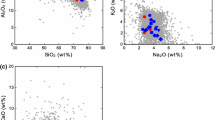Abstract
New experimental amphibole/melt partition coefficients from a variety of geologically relevant amphibole (pargasite, kaersutite, and K-richterite) and melt compositions obtained under conditions of interest to upper-mantle studies are combined with the results of X-ray single-crystal structure refinement. The ideal cation radii (r0), calculated using the lattice-site elastic-strain model of Blundy and Wood (1994) under the hypothesis of complete REE (rare earth elements) ordering at [8]M4, mostly differ significantly from those obtained from both the structure refinement and the ionic radius of [8]Ca2+. Heavier REE may also strongly deviate from the parabolic trends defined by the other REE. On the basis of the crystal-chemical knowledge of major-element site-preference in amphibole and the occurrence of two sites with different co-ordination within the M4 cavity (M4 for Ca and Na, M4′ for Fe2+ and Mg), we propose a new model for REE incorporation. LREE order at the [8]M4 site, whereas HREE prefer the M4′ site with lower co-ordination in amphiboles with a significant cummingtonite component, and may also enter the M2 octahedron, at least in richterite. This more complex model is consistent with the observed Amph/LD, and drops the usual assumption that REE behave as a homogeneous group and order at the M4 site. The availability of multiple crystal-chemical mechanisms for REE3+ incorporation explains why measured and estimated Amph/LDHREE may differ by up to one order of magnitude. When REE enter two different sites within the same cavity, a fit performed on the basis of a single curve may appear correct, but the values obtained for r0 are biased towards those of the dominant site, and the Young's modulus is underestimated. When REE are incorporated in multiple sites in different cavities, the observed pattern cannot be reduced to a single curve, and the partition coefficients of heavy REE would be strongly underestimated by a single-site fit. The simplistic assumption that REE occupy a single site within the amphibole structure can thus substantially bias predictive models based on the elastic-strain theory. Our combined approach allows linkage between fine-scale site preference and the macroscopic properties of minerals and provides more reliable predictive models for mineral/melt partitioning. After the possible site-assignments have been identified, the shape of the Onuma curves constructed from accurately determined Amph/LDREE now allows the active mechanisms for REE incorporation in amphiboles to be recognised even where site populations are not available. The REE preference for polyhedra with smaller size and lower co-ordination than those occupied by Ca invalidates the general idea that Ca acts as a “carrier” for REE.
Similar content being viewed by others
Author information
Authors and Affiliations
Additional information
Received: 17 March 1999 / Accepted: 11 June 1999
Rights and permissions
About this article
Cite this article
Bottazzi, P., Tiepolo, M., Vannucci, R. et al. Distinct site preferences for heavy and light REE in amphibole and the prediction of Amph/LDREE . Contrib Mineral Petrol 137, 36–45 (1999). https://doi.org/10.1007/s004100050580
Issue Date:
DOI: https://doi.org/10.1007/s004100050580




